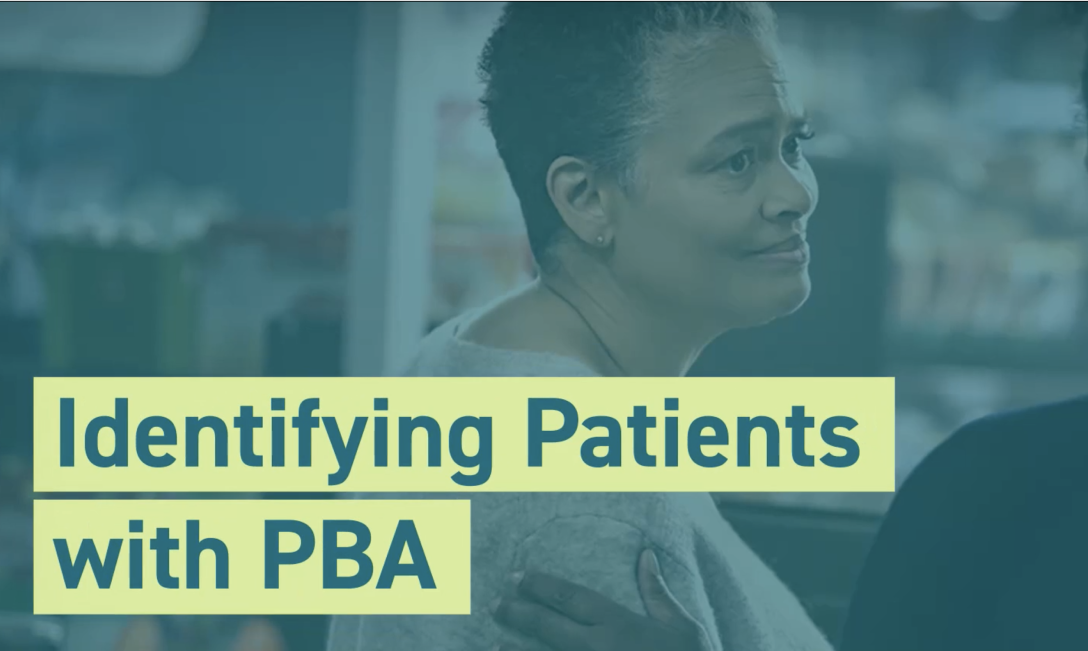

Diagnosing PBA
Ask the right question to
diagnose PBA1
Knowing what to ask your patients is important for reaching an accurate diagnosis. Start the conversation1
Mary Beth, patient living with PBA, and actor portrayal.
Three steps to help assess for PBA
Pseudobulbar Affect (PBA) can only be diagnosed following a complete assessment by a qualified healthcare provider.
Ask a simple question like this one1:
“Do you ever cry or laugh but it feels odd because you’re not actually sad or amused?”
Differentiate between PBA and depression2-4
Document your confirmed diagnosis with ICD-10 code F48.25*
Or for help identifying PBA symptoms, you can use the Center for Neurologic Study-Lability Scale (CNS-LS) screening tool.†
*ICD-10 diagnosis codes are provided for informational purposes only and do not guarantee that billing codes will be appropriate or that coverage and reimbursement will result. Providers should consult with their payers for all relevant coverage, coding, and reimbursement requirements. It is the sole responsibility of the provider to select proper codes and ensure the accuracy of all claims used in seeking reimbursement. This resource is not intended as legal advice or as a substitute for a provider’s independent professional judgment.
†CNS-LS is a self-administered questionnaire, designed to be completed by the patient with a 7-item rating scale that measures perceived frequency and severity of PBA episodes. It was validated as a screening tool in amyotrophic lateral sclerosis and multiple sclerosis populations.4,6 A CNS-LS score of ≥13 may suggest PBA symptoms, and a score of ≥21 may suggest more severe and frequent PBA symptoms.7
What is it like to experience a PBA episode?
View examples of patients experiencing crying and laughing episodes.
PBA episodes may:

Appear with or without tears

Sound noiseless or quiet

Sound noisy with increasing volume

Appear with or without grimacing

Appear as uncontrollable laughter

Appear only briefly
Nurses and other staff members may also describe your patient’s symptoms in different ways. Look for some of the following terms in patient charts that may suggest PBA3,4,8:
- Emotional incontinence
- Emotional lability
- Inappropriate affect
- Involuntary expression
- Mood incongruence
- Pathological laughing and crying
- Sudden or emotional outbursts of laughing or crying
If you recognize these symptoms in your patient and confirm PBA, learn more about dosing and treatment with NUEDEXTA.
dosing & treatment-
References:
1.
Suavé WM. Recognizing and treating pseudobulbar affect. CNS Spectr. 2016;21(S1):34-44. doi:10.1017/S1092852916000791
-
2.
Kekere V, Qureshi D, Thanju A, Fouron P, Olupona T. Pseudobulbar affect mimicking depression: a case report. Cureus. 2022;14(6):e26235. doi:10.7759/cureus.26235
-
3.
Nuedexta. Package insert. Otsuka America Pharmaceutical, Inc.; 2022.
-
4.
Hammond FM, Alexander DN, Cutler AJ, et al. PRISM II: an open-label study to assess effectiveness of dextromethorphan/quinidine for pseudobulbar affect in patients with dementia, stroke or traumatic brain injury. BMC Neurol. 2016;16:89. doi:10.1186/s12883-016-0609-0
-
5.
Centers for Disease Control and Prevention. ICD-10-CM tabular list of diseases and injuries. Accessed June 12, 2024. https://ftp.cdc.gov/pub/health_statistics/nchs/publications/ICD10CM/2022/icd10cm-tabular-2022-April-1.pdf
-
6.
Pioro EP, Brooks BR, Cummings J, et al. Dextromethorphan plus ultra low-dose quinidine reduces pseudobulbar affect. Ann Neurol. 2010;68(5):693-702. doi:10.1002/ana.22093
-
7.
Brooks BR, Crumpacker D, Fellus J, Kantor D, Kaye RE. PRISM: a novel research tool to assess the prevalence of pseudobulbar affect symptoms across neurological conditions. PLoS One. 2013;8(8):e72232. doi:10.1371/journal.pone.0072232
-
8.
Miller A, Pratt H, Schiffer RB. Pseudobulbar affect: the spectrum of clinical presentations, etiologies and treatments. Expert Rev Neurother. 2011;11(7):1077-1088. doi:10.1586/ern.11.68
Copay savings card
Share this card with your eligible patients to help them save on their NUEDEXTA prescription and refills.
10-day sample
Eligible healthcare providers can request a free 10-day sample of NUEDEXTA for appropriate patients.
